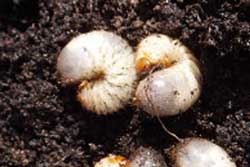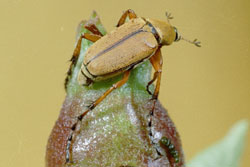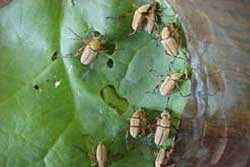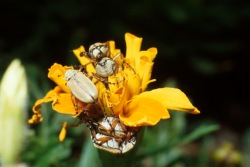Rose Chafer—Macrodactylus subspinosus
Adult rose chafers feed primarily on flower blossoms, especially roses and peonies, causing large, irregular holes. They damage fruits, particularly grape, raspberry, and strawberry. They also feed on the foliage of many trees, shrubs and other plants, such as rose, grape, apple, cherry, and birch, typically damaging leaves by eating the leaf tissue between the large veins, a type of injury known as skeletonizing. Rose chafers are generally found in areas with sandy soil. They contain a toxin that can be deadly to birds, including chickens, and small animals. The larvae feed on the roots of grasses and non-crop plants; they do not cause damage to home lawns or landscape plants.
see also White Grubs
Click on images to view full-size
Identification and Control Information
- Fact Sheet: Rose Chafer (PDF)—North Carolina State University
- UNH Cooperative Extension Info Line Question of the Week: Rose Chafer (PDF)
- Rose Chafers (PDF)—University of Minnesota Extension
- Deciduous Tree and Shrub Disorder: Skeletonizing by Rose Chafer (PDF)—University of Wisconsin Extension
- Beetles on Ornamental Plants (PDF)—University of New Hampshire Cooperative Extension
[Photos, left to right: (rose chafer larvae) unknown; (rose chafer adult) Clemson University - USDA Cooperative Extension Slide Series, Bugwood.org; (rose chafer adults on leaf) University of Wisconsin Entomology; (blossom damage) Jeff Hahn, University of Minnesota Extension]



